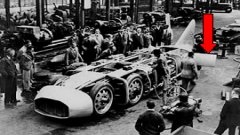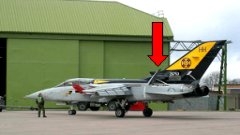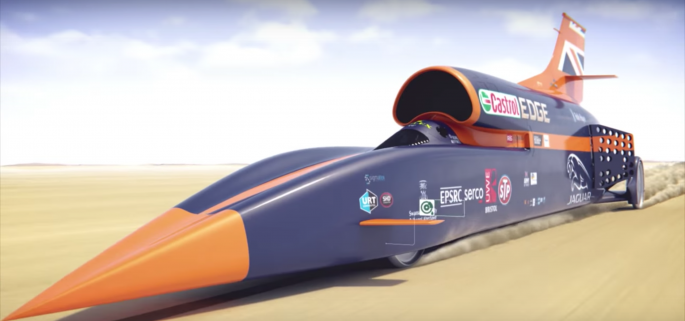By Andy Green
Having a design where one of our big problems is having too much speed, and therefore having trouble slowing down, is a really nice problem to have for a land speed record car! However, it does present us with a big challenge, not least because of how the record attempt is measured.
Setting a World Land Speed Record requires two runs through the measured mile (and kilometre) in opposite directions within 1 hour. The quickest and simplest way to achieve this is to stop the Car, after the first run, at the point where we want to start the second run. Put another way, with the measured mile in the middle of the track, if we make the acceleration distance and deceleration distances the same then we won’t waste any time having to tow the Car to the start point for the return run.
The challenge
Our early simulation work suggests that we will be able to get BLOODHOUND SSC up to 1000mph in 4.5 miles. This leaves us with a problem – we need to stop the 7.5 tonne Car from travelling at 1000mph in just 4.5 miles. And just to make this a bit harder, the vehicle has been designed to be as slippery through the air ('low-drag') as possible.
Up to about 160mph, ‘conventional’ car disc brakes can be used. These discs will have to endure the same spin speeds of over 10 000rpm that the wheels will experience, with similarly massive stresses, so they are somewhat different to ‘normal’ car brakes. The BLOODHOUND solution is to use steel brake discs which can be spun to 10,000rpm and six pot brake calipers from AP Racing (a manufacturer of big racing car brakes).
Above 160mph, however, we have to lose a lot of energy in a short space of time. We considered exotic solutions such as retro-rockets, but they have a number of drawbacks (they would de-stabilise the vehicle, would require a blow-off cover that could then come back and hit the vehicle, could misfire and push the Car sideways, and so on - none of these things are good). So we rapidly settled on two robust and independent solutions – airbrakes and drag parachutes.
Airbrakes
Airbrakes are commonly used in aircraft to slow them down from high speeds and are mechanically simple to operate. They have also been around for a long time in the world of land speed records.

 Left: George Eyston used airbrakes to slow his massive 7-ton Thunderbolt from over 350 mph in the 1930s
Left: George Eyston used airbrakes to slow his massive 7-ton Thunderbolt from over 350 mph in the 1930s
Right : A Tornado F3’s airbrakes extend on either side of the fin.
The problem with airbrakes is that to stop BLOODHOUND in the required distance, the airbrakes would virtually have to double the cross-sectional area (and therefore drag) of the Car, which is technically quite challenging! Hence we are including the largest airbrakes that we can in order to minimise our reliance on parachutes and to reduce the length of the safety overrun at the ends of the track, in case the parachutes fail.
Parachutes
Brake parachutes have also been around for a long time, in both aerospace and vehicle applications. Everything from Thrust SSC to the Space Shuttle has used them to slow down.
BLOODHOUND’s parachute design is being finalised on the basis of the detailed performance figures for the Car, which are in turn based on the predictions of aerodynamic drag generated by computational fluid dynamics. However, in general terms, we expect to be deploying the chutes at anything up to 600mph, which will add a drag load of anything up to 6 tonnes to the Car. This will add another 1 ‘g’ to the Car’s deceleration – in other words, it will reduce the speed by an extra 20mph every second.
Aerodynamic drag
The problem with both the airbrake and parachute solutions is that they rely on aerodynamic drag, which changes with speed. Aero drag is proportional to the square of the speed: the drag at 800mph is four times as high as the drag at 400mph, which is four times as great as the drag at 200mph. Hence an airbrake that works well at 800mph will be ineffective at lower speeds.
To optimise the Car’s deceleration, and thus stop it in 4.5 miles, we need to increase the effectiveness of the airbrakes and/or deploy extra parachutes as we slow down.
Braking sequence
So how will we use these ideas together? This is how we hope to stop the Car:
- 1000mph: close the throttle – deceleration rate is 3g initially, then falls off rapidly
- 800mph: start to deploy the airbrake, gradually increasing its area to try and maintain 3g deceleration through the transonic region (800mph down to 650mph)
- Below 600mph: deploy a parachute to increase the deceleration rate back up to 3g
- Below 400mph: deploy a second parachute if required.
- Below 250mph: apply the wheel brakes as required to stop at the end of the track, ready for the turn round.
Stopping in a hurry
And if something goes wrong?
If we need to stop in a hurry, then using all of these systems in quick succession (airbrakes at 800mph, both parachutes at 600/400mph and then wheel brakes at 250mph) will stop the Car in well under 4.5 miles.
If the airbrakes fail, then the parachutes are being designed to stop the Car within 4.5 miles by themselves.
And if the parachutes both fail (which qualifies as really unlucky, but does happen – twice in Thrust SSC’s case) then the airbrakes will do what they can and the Car will have to use the track overrun. The larger the airbrakes that we can fit, the smaller the overrun required.
Why we're making it complicated
If this seems complicated, it’s because all of this is necessary if we are to run BLOODHOUND as safely as we intend to. For example, Craig Breedlove’s remarkable record run in 1965 almost ended in disaster when both of his parachutes failed. Spirit of America overshot at Bonneville and ended up nose-down in a brine pond, where Craig had to swim for survival. We need to learn from his experience and make sure that we don’t repeat it!



